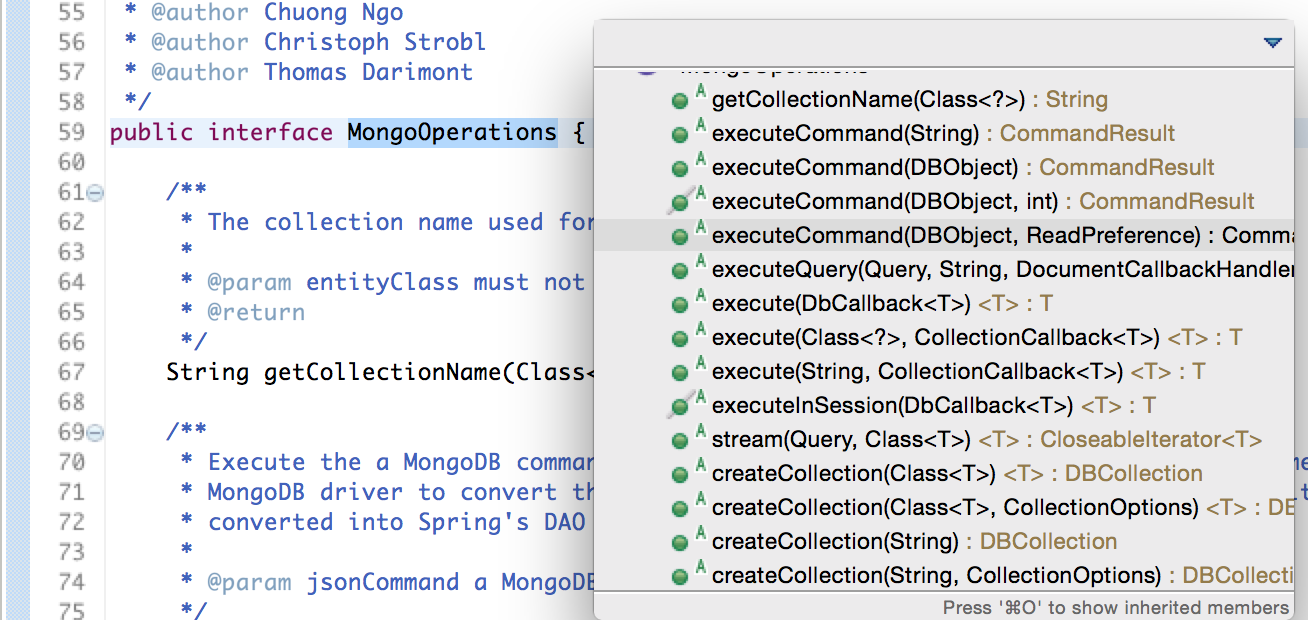在spring已经成为Java web开发者必学技能的今天,适应spring编程风格将有助于快速理解和学习spring相关项目,避开aop和ioc不谈,比如工厂方法模式的身影随处可见,今天讨论的是spring 访问mongo的API模板,这种模板化的处理方式,也是spring常见的,以下是几个例子:
1.spring-ldap-core中的ldapTemplate
2.spring-jdbc中的jdbcTemplate
3.mybatis-spring中的sqlSessionTemplate
4.spring-data-mongodb中的MongoTemplate
,等等吧,最近在做关于mongo的项目,所以讲讲MongoTemplate,本文的代码是基于
spring-data-commons-1.10.0.RELEASE.jar
spring-data-mongodb-1.7.0.RELEASE.jar
mongo-java-driver-3.2.2.jar
当然还会有spring环境的包,这不是本文的重点,所以忽略。
一、查看源码了解MongoTemplate
继续查看MongoOperations和ApplicationContextAware发现,MongoTemplate中的所有对mongo数据操纵的方法都是来自于接口MongoOperations:

至此,我们基本了解了MongoTemplate,我们已经迫切需要使用它了,那我们必须实例化它,所以有必要认识一下它的构造子:

可以看到,有四个构造函数可用,前俩个源码如下
public MongoTemplate(Mongo mongo, String databaseName) {
this(new SimpleMongoDbFactory(mongo, databaseName), null);
}
public MongoTemplate(Mongo mongo, String databaseName, UserCredentials userCredentials) {
this(new SimpleMongoDbFactory(mongo, databaseName, userCredentials));
}public MongoTemplate(MongoDbFactory mongoDbFactory) {
this(mongoDbFactory, null);
}
public MongoTemplate(MongoDbFactory mongoDbFactory, MongoConverter mongoConverter) {
Assert.notNull(mongoDbFactory);
this.mongoDbFactory = mongoDbFactory;
this.exceptionTranslator = mongoDbFactory.getExceptionTranslator();
this.mongoConverter = mongoConverter == null ? getDefaultMongoConverter(mongoDbFactory) : mongoConverter;
this.queryMapper = new QueryMapper(this.mongoConverter);
this.updateMapper = new UpdateMapper(this.mongoConverter);
// We always have a mapping context in the converter, whether it's a simple one or not
mappingContext = this.mongoConverter.getMappingContext();
// We create indexes based on mapping events
if (null != mappingContext && mappingContext instanceof MongoMappingContext) {
indexCreator = new MongoPersistentEntityIndexCreator((MongoMappingContext) mappingContext, mongoDbFactory);
eventPublisher = new MongoMappingEventPublisher(indexCreator);
if (mappingContext instanceof ApplicationEventPublisherAware) {
((ApplicationEventPublisherAware) mappingContext).setApplicationEventPublisher(eventPublisher);
}
}
}<!-- 加载mongodb的属性配置文件 -->
<context:property-placeholder location="classpath:/mongo/mongodb.properties" />
<!-- 构造MongoDbFactory对象 -->
<mongo:db-factory id="mongoDbFactory" host="${mongo.host}"
port="${mongo.port}" dbname="${mongo.dbname}" username="${mongo.username}"
password="${mongo.password}" />
<!-- 构造MongoTemplate -->
<bean id="mongoTemplate" class="org.springframework.data.mongodb.core.MongoTemplate">
<constructor-arg name="mongoDbFactory" ref="mongoDbFactory" />
</bean>
这样,我们需要的MongoTemplate实例会随着spring容器的启动而生成。下面我们要讨论的是基于该实例进行mongo的数据操纵(MongoDB的安装等环境准备工作省略)。
/**
* 查询分页数据
* @author young
* @param QueryEntity
* 查询条件分装实体
* @param entityClass
* 确定集合名称的实体类
*/
public <T> List<T> queryPageData(QueryEntity queryEntity, Class<T> entityClass) {
Assert.notNull(entityClass, "entityClass must not be null");
if (!hasCollection(entityClass)) {
logger.info("collection determied by entityClass not be found ");
return null;
}
Query query = QueryEntityConverter.getQueryStataments(queryEntity);
List<T> listResult = getMongoTemplate().find(query, entityClass);
return listResult;
}
/**
* 查询分页数据
* @author young
* @param queryEntity
* 查询条件分装实体
* @param collectionName
* 集合名称
* @return
*/
public List<? extends Object> queryPageData(QueryEntity queryEntity, String collectionName) {
Assert.notNull(collectionName, "collection name must not null");
if (!hasCollection(collectionName)) {
logger.info("collection named " + collectionName + " not be found");
return null;
}
Query query = QueryEntityConverter.getQueryStataments(queryEntity);
List<? extends Object> listResult = getMongoTemplate().find(query, Object.class, collectionName);
return listResult;
}/**
* 批量插入
* @author young
* @param json
* 需要插入的json串文档
* @param collectionName
* 集合名称
*/
public void insertMany(Object json, String collectionName) {
Assert.notNull(json, "you can not save a null object into a collection");
Assert.notNull(collectionName, "collection name must be determined by parameter collectionName");
if (!hasCollection(collectionName)) {
logger.info("collection named " + collectionName + " not be found b");
}
getMongoTemplate().insert(json, collectionName);
}
/**
* 批量插入
* @author young
* @param batchToSave
* 插入文档列表
* @param collectionName
* 集合名称
*/
public <T> void insertMany(List<T> batchToSave, String collectionName) {
Assert.notNull(batchToSave, "you can not save a null object into a collection");
Assert.notNull(collectionName, "collection name must be determined by parameter collectionName");
if (!hasCollection(collectionName)) {
logger.info("collection named " + collectionName + " not be found ");
}
getMongoTemplate().insert(batchToSave, collectionName);
}
/**
* 批量插入
* @author young
* @param batchToSave
* 插入文档列表
* @param entityClass
* 确定集合名称的实体类
*/
public <T> void insertMany(List<T> batchToSave, Class<T> entityClass) {
Assert.notNull(batchToSave, "you can not save a null object into a collection");
Assert.notNull(entityClass, "entityClass must not be null");
if (!hasCollection(entityClass)) {
logger.info("collection determied by entityClass not be found ");
return;
}
getMongoTemplate().insert(batchToSave, entityClass);
}/**
* @author young
* @param queryEntity
* 查询条件分装实体
* @param updateEntity
* 更新实体
* @param collectionName
* 集合名称
* @return
*/
public int updateMany(QueryEntity queryEntity, Map<String, Object> updateEntity, String collectionName) {
Assert.notNull(collectionName, "collection name must not be null ");
if (!hasCollection(collectionName)) {
logger.info("collection named " + collectionName + " not be found ");
return -1;
}
Query query = QueryEntityConverter.getQueryStataments(queryEntity);
Update update = UpdateEntityConverter.getKeysUpdateStatment(updateEntity);
return getMongoTemplate().updateMulti(query, update, collectionName).getN();
}
/**
* @author young
* @param queryEntity
* 查询条件分装实体
* @param updateEntity
* 更新实体
* @param entityClass
* 确定集合名称的实体类
* @return
*/
public <T> int updateMany(QueryEntity queryEntity, Map<String, Object> updateEntity, Class<T> entityClass) {
Assert.notNull(entityClass, "entityClass must not be null");
if (!hasCollection(entityClass)) {
logger.info("collection determied by entityClass not be found ");
return -1;
}
Query query = QueryEntityConverter.getQueryStataments(queryEntity);
Update update = UpdateEntityConverter.getKeysUpdateStatment(updateEntity);
return getMongoTemplate().updateMulti(query, update, entityClass).getN();
}/**
* 删除指定集合中的指定文档
* @author young
* @param collectionName
* 集合名称
* @param queryEntity
* 查询条件封装实体类,确定了需要删除的文档
* @return
*/
public int removeMany(QueryEntity queryEntity, String collectionName) {
Assert.notNull(collectionName, "collection name must not be null ");
if (!hasCollection(collectionName)) {
logger.info("collection named " + collectionName + " not be found ");
return -1;
}
Query query = QueryEntityConverter.getQueryStataments(queryEntity);
return getMongoTemplate().remove(query, collectionName).getN();
}
/**
* 删除指定集合中的指定文档
* @author
* @param queryEntity
* 查询条件封装实体类,确定了需要删除的文档
* @param entityClass
* 确定集合名称的实体类
* @return
*/
public <T> int removeMany(QueryEntity queryEntity, Class<T> entityClass) {
Assert.notNull(entityClass, "entityClass must not be null");
if (!hasCollection(entityClass)) {
logger.info("collection determied by entityClass not be found ");
return -1;
}
Query query = QueryEntityConverter.getQueryStataments(queryEntity);
return getMongoTemplate().remove(query, entityClass).getN();
}










 本文介绍如何使用Spring Data MongoDB中的MongoTemplate进行数据库操作,包括增删查改等基本操作,并探讨了MongoDB的一些高级特性。
本文介绍如何使用Spring Data MongoDB中的MongoTemplate进行数据库操作,包括增删查改等基本操作,并探讨了MongoDB的一些高级特性。
















 2833
2833

 被折叠的 条评论
为什么被折叠?
被折叠的 条评论
为什么被折叠?








